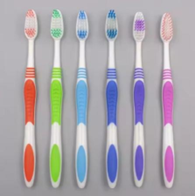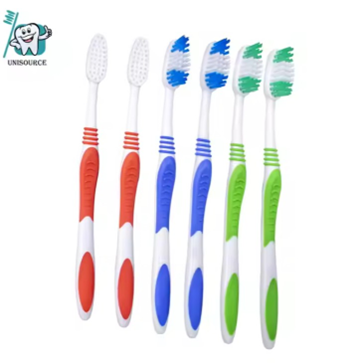Regular toothbrush replacement is critical for dental hygiene and well-being. Because your toothbrush is continually in contact with your teeth and gums, it may accumulate bacteria and lose effectiveness. Replace it on a regular basis to properly eliminate plaque and food particles while also preserving tooth health. Old toothbrushes may injure gums and enamel, resulting in long-term dental problems. Bristles wear out in both manual and electric toothbrushes, reducing brushing efficiency. To ensure optimal oral hygiene, toothbrush purchasers should change each toothbrush on a regular basis. The frequency with which a toothbrush should be replaced is also determined by its storage and usage. Let's talk about why it's important to change your toothbrush on a regular basis and how to keep it clean.

How Often Should You Replace Your Toothbrush?
Dentist-Recommended Timeline for Toothbrush Replacement
Regular toothbrush replacement, according to dentists, should be done every three to four months. Following this routine will ensure that your brushes will continue to clean your teeth and gums effectively. It is essential to replace the brushes sooner rather than later if they show signs of wear and strain before this period. Dentists also advise patients to replace their toothbrushes after each sickness since the bristles might harbor bacteria and germs that could reinfect the mouth. You may enhance your dental health and prevent ineffective brushing by keeping track of the condition of your toothbrush.
Signs That Indicate It's Time for a New Toothbrush
Several symptoms suggest that it's time for a new toothbrush. First, torn or bent bristles indicate that your toothbrush is no longer cleaning your teeth properly. If you observe discoloration or a change in the texture of the bristles, it may be time to replace them. Furthermore, a worn-out handle or any foul odor emanating from the toothbrush indicates that it has outlived its usefulness. Regularly checking your toothbrush can allow you to detect when it is no longer operating properly and avoid long-term oral health problems.
Factors That Affect Your Toothbrush's Lifespan
Several things may influence the longevity of your toothbrush. The frequency of usage is a key aspect; the more you brush, the faster the bristles wear out. Brushing with more power might also result in quicker wear. Brushing too forcefully, for example, might cause bristles to fray and limit cleaning efficacy. Environmental variables such as humidity, storage conditions, and exposure to harsh chemicals may also affect toothbrush quality. Purchasing toothbrushes in bulk allows you to ensure you have a replacement ready when these factors reduce the effectiveness of your toothbrush.

What Happens If You Don't Replace Your Toothbrush?
Bacteria and Germ Buildup in Old Toothbrushes
If you do not change your toothbrush on a regular basis, bacteria and germs may build up on the bristles. After each usage, some germs from your mouth may remain on the toothbrush. Without adequate cleaning or replacement, these bacteria may proliferate over time, potentially leading to reinfections or other oral health difficulties. Old toothbrushes provide a breeding environment for germs, including those that may cause gum disease and cavities. To minimize bacterial accumulation, change your toothbrush every few months and follow the correct cleaning and storing procedures.
Reduced Cleaning Efficiency from Frayed Bristles
As a toothbrush age, the bristles tear and lose form. This reduces the effectiveness of your brushing since frayed bristles can no longer remove plaque and food particles from your teeth. Old toothbrushes have a limited cleaning capacity and cannot reach regions between teeth or along the gum line, resulting in plaque accumulation, cavities, and gum disease. Replacing your toothbrush as the bristles begin to wear guarantees that you continually get the optimum benefits from your brushing regimen while also safeguarding your oral health.
Increased Risk of Gum Disease and Cavities
Using an outdated toothbrush raises the risk of gum disease and cavities. As the bristles wear down, they lose effectiveness in eliminating plaque and food particles. Plaque accumulation on your teeth may produce tartar, which contains germs that cause tooth damage and gum irritation. Inadequate brushing caused by a worn-out toothbrush may increase the growth of dangerous germs, leading to oral infections, gum disease, and cavities. Regularly replacing your toothbrush helps to prevent these dangers while also keeping your gums and teeth healthy and clean.
How to Choose the Right Toothbrush for Optimal Oral Health?
Manual vs. Electric Toothbrush: Which Lasts Longer?
In terms of lifespan, there are benefits and drawbacks to both electric and manual toothbrushes. The durability of a manual toothbrush depends on the user's brushing technique, although it usually lasts three months with regular usage. In contrast, the bristles of electric toothbrushes tend to last longer, although the heads do require replacing every so often. Heads for electric toothbrushes typically last anywhere from one to three months before needing replacement. However, this may vary greatly based on the user's habits and how well the brush is taken care of. With the right approach, you may get the best of both sorts.
Soft, Medium, or Hard Bristles: Which is Best?
Your brushing experience could be greatly affected by the hardness of the bristles you choose. The Unisource Hotel toothbrush has soft bristles, which are popular because they are easy on the gums while yet doing a good job of removing plaque. Brushes with medium bristles are great for those who want a more forceful action, but they may be rough on delicate gums if not used correctly. If you want to keep your gums and enamel in good condition, you should stay away from bristles that are too hard. For optimal oral health protection and a pleasant brushing experience, it is essential to choose the right bristle type.
Eco-Friendly Toothbrush Options and Sustainability
Eco-friendly toothbrushes have grown in popularity as people become more concerned about the environment. Many manufacturers provide environmentally friendly choices manufactured from biodegradable materials like bamboo or recycled plastics. If you want to be environmentally conscious, try using a bamboo toothbrush with nylon bristles, which is a more sustainable alternative to plastic. Many eco-friendly toothbrushes are intended to give the same level of care while reducing environmental effects. Whether you're searching for a toothbrush for personal use or in bulk for hotels, sustainability can still meet your dental care requirements.
Best Practices for Maintaining Your Toothbrush
Proper Storage to Prevent Bacterial Growth
Properly storing your toothbrush may help prevent the growth of microorganisms. To remove any leftover toothpaste or grime, give the toothbrush a good rinsing with water after each use. Make sure it's stored upright and in a well-ventilated area to dry naturally. Do not store your toothbrush in a sealed container; doing so could lead to the growth of mold and germs. In public areas, such as hotels, it is especially important to keep toothbrushes apart to prevent the spread of germs. You can extend the life of your toothbrush and protect your teeth by storing it correctly.
Cleaning and Disinfecting Your Toothbrush Correctly
Cleaning your toothbrush on a regular basis is essential for keeping it clean. After each usage, clean the toothbrush well with hot water to disinfect it. To sterilize the bristles and handle them, immerse them in a vinegar-water solution or use mouthwash on a regular basis. This helps to destroy germs and prevent accumulation, which may produce smells. For those who want a more thorough cleaning, boil your toothbrush for a few minutes. Regularly cleaning your toothbrush keeps it germ-free and safe for continuous usage.
When to Replace a Toothbrush After Illness
After recuperating from an illness, it is essential to change your toothbrush. Germs and germs from the sickness may remain on the bristles, perhaps leading to reinfection. Whether you have a cold, the flu, or a bacterial illness, switching your toothbrush prevents you from reintroducing hazardous germs into your mouth. This is particularly crucial for manual toothbrushes with soft bristles since they might retain more germs. To preserve your health, change your toothbrush as soon as you're feeling better, even if you used it throughout your recuperation.
Conclusion
Replacing your toothbrush on a regular basis is a simple yet essential oral health activity. Brushing every three to four months is recommended by the dentist to remove plaque and bacteria, hence reducing gum disease and cavity risk. Choosing the right toothbrush, whether manual with soft bristles or electric and properly cleaning and storing it will help you get the most out of your brushing routine. To preserve excellent dental health, people should choose high-quality goods such as the Unisource anti-slip handle toothbrush. Changing, cleaning, and storing your toothbrush on a regular basis can help it last longer and keep your teeth and gums healthy for years. To maintain good oral health, inspect and replace your toothbrush on a regular basis.






